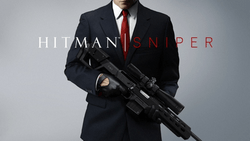Hitman: Sniper
| Hitman: Sniper | |
|---|---|
 | |
| Developer(s) | Square Enix Montreal |
| Publisher(s) | Square Enix |
| Platform(s) | Android, iOS |
| Release date(s) | June 3, 2015 |
| Genre(s) | First-person shooter |
| Mode(s) | Single-player |
Hitman: Sniper is a 2015 mobile first-person shooter video game in the Hitman series, released by Square Enix Montreal for Android and iOS platforms on June 3, 2015.
Gameplay

As Agent 47, the standard hitman protagonist of the Hitman series, the player is led to assassinate several powerful figures who have assembled at three upscale, lakefront houses. The game is played through first-person vision of a sniper scope, such that Agent 47 is not vulnerable to counterattack but can fail the mission if the targets notice the scheme and leave the premises. The game becomes a puzzle of isolating targets such that others nearby will not be alerted and, in turn, alert others at the compound. The player experiments with alternative methods for killing the targets, such as shooting out glass and letting targets fall to their deaths rather than killing them directly. As the game progresses, the player unlocks new weapons and weapon abilities as rewards from several activities: points accrued from successfully killing targets, leaderboard rankings, and "blueprint" collectibles dropped by targets.[1] Missions are constructed around killing one of ten important targets and a secondary objective, such as a stylized kill within a time limit.[2]
Development
Hitman: Sniper is an extension of the Sniper Challenge promotional minigame from Square Enix's 2012 Hitman: Absolution.[3][4]
Reception
| Reception | ||||||||||||||||
|---|---|---|---|---|---|---|---|---|---|---|---|---|---|---|---|---|
| ||||||||||||||||
The game received "generally favorable" reviews, according to video game review aggregator Metacritic.[5] Reviewers praised the cleverness and minimalism of its puzzle design,[1][2] but wanted more variety from its scenarios.[2][6] They noted how they came to know characters intimately through learning how they would react to his efforts to coax them.[1][2] This predictability felt great, the TouchArcade reviewer wrote, when he could react by instinct to new combinations of targets, but the game mechanics also became repetitive quickly. It also required that players memorize the routes of the game's characters.[2]
The GameZebo reviewer commended how the game's setting remained consistent yet fresh and exciting as new targets and complications were added to his list. The reviewer had special praise for the game's sound design, and how it was used to clue the player into puzzle solutions.and criticized the game's core multiplier ability for breaking the balance of the game.[1] The TouchArcade reviewer commended how the game's sparse story unfolded by watching the assassination targets go about their time at the compound, though he also noted that his suspension of disbelief was broken when characters would eventually return to partying after reacting to a gunshot, but suggested that the game's Easter eggs redeemed its psychopathic qualities.[2]
References
- 1 2 3 4 5 http://www.gamezebo.com/2015/06/09/hitman-sniper-review-right-target/
- 1 2 3 4 5 6 7 http://toucharcade.com/2015/06/09/hitman-sniper-review/
- ↑ https://www.rockpapershotgun.com/2015/09/07/have-you-played-hitman-sniper-challenge/
- ↑ https://www.destructoid.com/hitman-sniper-opens-fire-on-ios-android-today-293306.phtml
- 1 2 "Hitman: Sniper Critic Reviews for iPhone/iPad". Metacritic. Archived from the original on June 19, 2016. Retrieved June 19, 2016.
- 1 2 http://www.pocketgamer.co.uk/r/iPad/Hitman%3A+Sniper/review.asp?c=65757